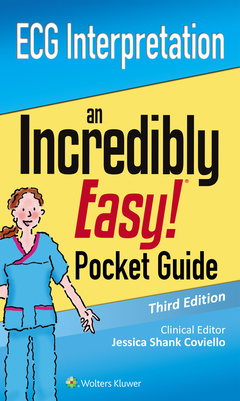Description
ECG Interpretation: An Incredibly Easy Pocket Guide (3rd Ed.)
Incredibly Easy! Series® Series
Author: LWW
Language: English
Subject for ECG Interpretation: An Incredibly Easy Pocket Guide:
Publication date: 12-2016
304 p. · 10.8x18.1 cm · Paperback
304 p. · 10.8x18.1 cm · Paperback
Description
/li>
New at ECG interpretation? No need to go it alone—keep the basic skills and concepts at your fingertips, with ECG Interpretation: An Incredibly Easy!® Pocket Guide .
Use this enjoyable reference for at-a-glance reviews of how to use and monitor ECG equipment, obtain and interpret rhythm strips, and accurately spot and treat arrhythmias. Full of helpful charts, illustrations, and easy-to-relate-to definitions, this is the perfect on-the-spot guide for students, new nurses, and all those looking for expert guidance on the job.
Increase on-the-job or classroom confidence with this must-have pocket guide, featuring:
About the Clinical Editor
Jessica Shank Coviello, DNP, APM, ANP-BC, is Associate Professor and Director of the Doctor of Nursing Practice Program at Yale Univers
Use this enjoyable reference for at-a-glance reviews of how to use and monitor ECG equipment, obtain and interpret rhythm strips, and accurately spot and treat arrhythmias. Full of helpful charts, illustrations, and easy-to-relate-to definitions, this is the perfect on-the-spot guide for students, new nurses, and all those looking for expert guidance on the job.
Increase on-the-job or classroom confidence with this must-have pocket guide, featuring:
- NEW and updated content in quick-read, bulleted format, with easy-to-remember guidance on topics including: o Identifying and interpreting atrial, junctional, ventricular, sinus node, and atrioventricular arrhythmias o ECG effects of electrolyte imbalances o ECG effects of antiarrhythmics o Basic and advanced electrocardiography, including equipment uses and components o Waveform types and components
- Dozens of photos, drawings, and diagrams clearly outline key concepts, including:
- 8-step method of ECG evaluation
- Identifying and monitoring disorders, rhythm disturbances, and electrolyte imbalances
- Placement of different types of leads
- Identifying and solving monitor problems
- Interventions – Administering nonpharmacologic and pharmacologic treatments for arrhythmias, including pacemakers, ICDs, and antiarrhythmics
- Memory jogger – Memory tricks that help you remember key concepts and treatments Through the ages – Identifies differences in ECG interpretation and pacemaker needs, according to the patient’s age
- Help desk – Explanations of monitoring equipment components and functions What causes it – Causes of different disorders, imbalances, and arrhythmias What to look for – Tips on identifying and interpreting arrhythmiaHow it’s treated – Steps to take for a variety of treatment“Nurse Joy” and “Nurse Jake” – Expert insights on ECG methods and problem-solving
- The Test Zone – Practice Q&A
- Quick guide to arrhythmias
- ACLS algorithms: The Pulseless Arrest, Tachycardia, and Bradycardia
- Guide to antiarrhythmic drugs
- Guide to choosing monitoring leads
About the Clinical Editor
Jessica Shank Coviello, DNP, APM, ANP-BC, is Associate Professor and Director of the Doctor of Nursing Practice Program at Yale Univers
© 2024 LAVOISIER S.A.S.




